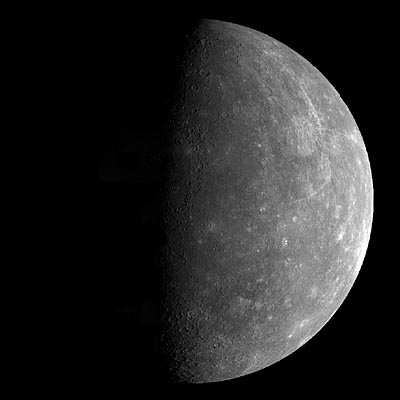More on Mercury
Astronomers thought that Mercury might have a tenuous atmosphere of hydrogen, helium, sodium and potassium gases. Careful observations revealed that the gasses all come from the Sun as part of the solar wind. The gas is only temporarily trapped by Mercury, then escapes after a while. Sodium and potassium come from Mercury's surface. The highest energy particles in the solar wind hit the surface blasting off potassium and sodium atoms which eventually also leave the planet.

The Mass of Mercury
Mercury has no satellites of its own, no Mercurian Moons. For this reason
it was not easy to calculate its mass. Astronomers had made some rough
estimates of Mercury's mass from observations of the perturbations that
Mercury caused on the orbits of other planets. But this estimates were not
very accurate.
When Mariner 10 arrived at Mercury, astronomers were able to calculate the mass of Mercury more accurately than before by observing the effect of Mercury on the Mariner 10 spacecraft.
Mercury's Interior and Magnetism
Dividing Mercury's now known mass by its volume, we find that the
density of Mercury is about 5.5 times that of water. This means that
Mercury must have a very large iron core compared to the Earth (and
certainly compared to the Moon).
The ingredients for a magnetic field were a molten iron core and
rotation. On Mercury we definitely have an iron core, should we then expect
a magnetic field?
Mariner 10 did detect a magnetic field on Mercury, 100 times weaker than that on Earth. Astronomers disagree about what causes this weak magnetic field. Since Mercury is so small, the iron core is solid and not liquid. Mercury's slow rotation can't help either. But the fact remains that Mercury does have a magnetic field.
These questions will remain until another spacecraft visits Mercury and gathers more and more accurate data about the planet
Ice on Mercury?
It appears so. Ground based measurements indicate a material with
a very high reflectivity, almost certainly ice. The ice is located deep down
inside some crater floors, protected from the Sun's direct rays. This
will be an important thing for MESSENGER to investigate and confirm
in a few years.
But where did the ice come from? Comets impacting Mercury's surface.